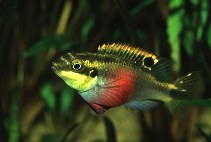| Family: |
Cichlidae (Cichlids), subfamily: Pseudocrenilabrinae |
| Max. size: |
11 cm TL (male/unsexed) |
| Environment: |
demersal; freshwater; brackish; pH range: 5 - 8; dH range: 5 - 19, |
| Distribution: |
Africa: eastern Benin, southern Nigeria and western Cameroon (Ref. 81260). |
| Diagnosis: |
Dorsal spines (total): 14-17; Dorsal soft rays (total): 8-10; Anal spines: 3-3; Anal soft rays: 6-8. Diagnosis: body elongate, moderately compressed, its depth 28.4-36.8% of standard length; head length 27.8-34.5% of standard length; 4-5 rows of monocuspid teeth in jaws; dorsal fin usually with spots or bands, dark posteriorly; lower part of body often reddish in life (Ref. 53405). Black mid-lateral band extends over caudal fin; base of dorsal fin heavily pigmented dark grey or black (Ref. 81260).
Description: moderately gracile (body depth 29.3-38.3%, mean 34.3% SL); head length 27.8-33.0% SL; dorsal head profile smoothly rounded to snout; snout short, 21.7-36.6% HL, rounded; ventral body wall gently rounded to caudal peduncle which is usually deeper than long; distance from snout to pelvic origin 33.4-40.9%, mean 37.2% SL (Ref. 81260). Pharyngeal jaw teeth bicuspid; no micro-gillrakers; scales cycloid (Ref. 53405). 8-12 tuberculate rakers on hypobranchial and ceratobranchial of first gill arch, 3-6 short epibranchial rakers; caudal fin rounded in both sexes, sometimes upper half elongate and lobe-like in males; males usually 15-25% larger than females, with soft dorsal and anal rays more elongated (Ref. 81260). Caudal fin always rounded in females, in males it can be rounded, rhomboid or sometimes with a slightly elongated upper lobe (Ref. 52307).
Coloration: live: males: dark olivaceous-green above, with dark, grey longitudinal band running from eye to posterior part of dorsal-fin base; another dark grey horizontal band extends from snout to hind margin of caudal fin; lower part of body light olivaceous-green, belly pinkish; 2 narrow, dark grey cross bars on upper part of head and another at level of lower lip; opercular region olive-green, with golden reflections and metallic, copper-red to black spot, edged with bright green ventrally; dorsal fin hyaline except for black area behind dark red distal margin, with light blue submarginal band; pectoral fins hyaline except for some traces of olive-green at base and light violet near hind margin; pelvic fins violet, with black anterior margin and bright blue submarginal band; anal fin violet and black-edged; caudal fin violet above horizontal band and olive-green or orange below; upper caudal margin dark red, with dark orange submarginal band; sometimes 1 (rarely more) round, black, orange-edged spot on upper part of caudal fin (Ref. 53405). Cheeks and opercle variably colored: with yellow, red or blue flush; chest and belly red or yellow (rarely blue) (Ref. 81260). Females: horizontal bands on body darker grey than in males; dorsal fin lacking red and blue margins which are replaced by narrow black band; posterior black area subdivided into several irregular black zones or occasionally substituted by 1-2 round, black spots; pectoral fins hyaline; pelvic fins light pink rather than violet, and with blue and black margins; caudal fin lacking orange-red margin which is replaced by golden spots; upper part of caudal fin sometimes with 1 (or several) round, black spots bordered by golden area (Ref. 53405). Cheeks usually yellow, opercle yellow or blue; chest and belly red or violet (Ref. 81260). |
| Biology: |
Feeds on worms, crustaceans and insects (Ref. 7020). In the river Sombreiro (Nigeria) observed to mainly feed on diatoms, algae, higher plants and detritus (Ref. 52307). Pair bonding (Ref. 52307), cave-spawning (Ref. 52307, 81260), substrate brooder (Ref. 81260). Aquarium keeping: in pairs; minimum aquarium size 80 cm (Ref. 51539). |
| IUCN Red List Status: |
Least Concern (LC); Date assessed: 22 April 2019 Ref. (130435)
|
| Threat to humans: |
harmless |
Source and more info: www.fishbase.org. For personal, classroom, and other internal use only. Not for publication.
